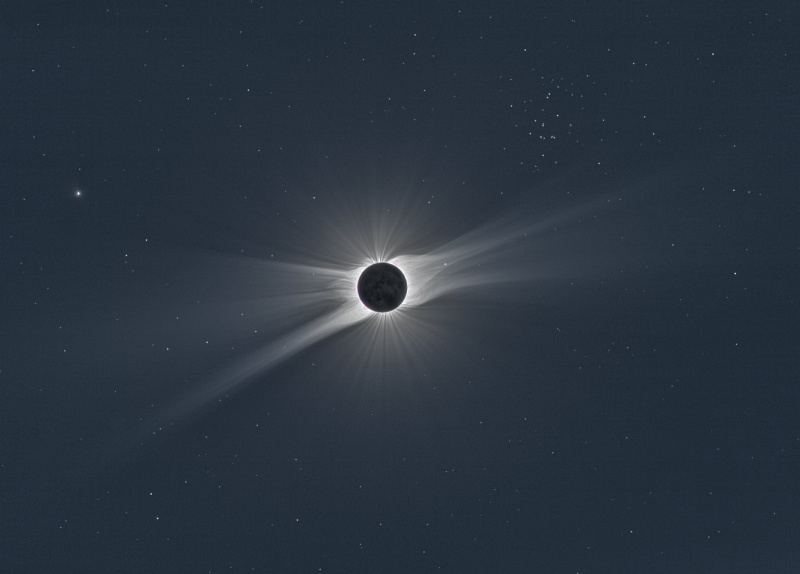Credit & Copyright: Miloslav
Druckmuller (Brno University of Technology),
Peter Aniol,
Vojtech Rusin
Explanation:
For a moment on August 1st, the daytime
sky grew dark along the path of a
total solar eclipse.
While watching the geocentric
celestial event from Mongolia,
photographer Miloslav Druckmuller recorded multiple images with
two separate cameras as
the Moon blocked the bright solar
disk and darkened the sky.
This final composition
consists of 55 frames ranging in exposure
time from 1/125 to 8 seconds.
It spans nearly 12 degrees,
with the relative position of the Moon and Sun corresponding to
mid-eclipse.
On the left is bright planet Mercury,
but many stars are also
visible, including the Praesepae star cluster (also known as M44
or the Beehive cluster)
in Cancer, above and to the right of the silhouetted Moon.
Remarkably, the nearly perfect conditions and wide range
in individual exposures allow the composite picture to
register the lunar surface and follow the delicate
solar corona
out to a distance of nearly 20 times the radius of the Sun.
In fact, the composite presents a range in brightness
beyond what the eye could see
during
the eclipse.
1999 2000 2001 2002 2003 2004 2005 2006 2007 2008 2009 2010 2011 2012 2013 2014 2015 2016 2017 2018 2019 2020 2021 2022 2023 2024 2025 |
Январь Февраль Март Апрель Май Июнь Июль Август Сентябрь Октябрь Ноябрь Декабрь |
NASA Web Site Statements, Warnings, and Disclaimers
NASA Official: Jay Norris. Specific rights apply.
A service of: LHEA at NASA / GSFC
& Michigan Tech. U.
|
Публикации с ключевыми словами:
total solar eclipse - star cluster - Солнечное затмение - полное солнечное затмение - звездное скопление - Солнечная корона
Публикации со словами: total solar eclipse - star cluster - Солнечное затмение - полное солнечное затмение - звездное скопление - Солнечная корона | |
См. также:
Все публикации на ту же тему >> | |
Мнение читателя [1]
